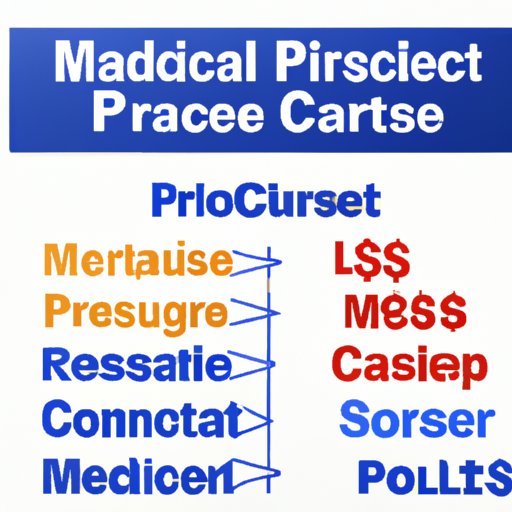Introduction
Medicare is a national health insurance program in the United States that provides health care coverage for people who are 65 or older, certain disabled people, and people with end-stage renal disease. With more than 60 million Americans currently enrolled in Medicare, it’s important to understand when someone is eligible for this program and what types of coverage are available. In this article, we’ll explore the eligibility criteria for Medicare, the different coverage options available, and the cost of Medicare in relation to other health care plans.
Signing Up for Medicare
In order to be eligible for Medicare, you must be 65 years old or older, have been a permanent resident of the United States for at least five consecutive years, and be either a U.S. citizen or a legal immigrant. You may also be eligible if you are under 65 and have certain disabilities or end-stage renal disease.
The process for signing up for Medicare is relatively simple. If you are already receiving Social Security or Railroad Retirement Board benefits, you will automatically be enrolled in Medicare Parts A and B when you turn 65. If you are not receiving these benefits, you can sign up during your Initial Enrollment Period, which begins three months before the month you turn 65 and ends three months after the month you turn 65.
You can apply for Medicare online through the Social Security Administration website or by visiting your local Social Security office. If you choose to apply online, you’ll need to create an account and provide information such as your Social Security number, date of birth, and address. Once you’ve submitted your application, you should receive your Medicare card in the mail within 30 days.

Different Types of Medicare Coverage Options
Once you’ve signed up for Medicare, you can choose from a variety of coverage options. Original Medicare includes Part A (hospital insurance) and Part B (medical insurance). Part A covers hospital stays, skilled nursing facility care, home health care, and hospice care. Part B covers doctor visits, preventive services, outpatient care, durable medical equipment, and some home health care.
In addition to Original Medicare, there are several other types of coverage options available. Medicare Advantage plans are offered by private insurers and include all of the benefits of Original Medicare plus additional benefits such as vision, dental, and hearing coverage. Medicare Supplement plans are also offered by private insurers and help cover out-of-pocket costs such as copayments, coinsurance, and deductibles.
The cost of each coverage option varies depending on the type of plan you choose, the insurer, and your location. Generally, Medicare Part A has no monthly premium, while Medicare Part B has a standard monthly premium of $148.50. Medicare Advantage plans typically have a monthly premium between $0 and $100, while Medicare Supplement plans typically have a monthly premium between $70 and $200.
Supplementing Medicare with Private Insurance
Many people choose to supplement their Medicare coverage with private insurance. Private insurance plans can help cover the gaps in coverage left by Original Medicare, such as prescription drugs, long-term care, and dental care. Private insurance plans can also help reduce out-of-pocket costs for things like copayments, coinsurance, and deductibles.
Private insurance plans typically have a monthly premium, but the cost varies depending on the type of plan you choose and the insurer. Additionally, some private insurance plans may require you to pay an annual deductible before they begin to pay for your health care expenses.

Cost of Medicare in Relation to Other Health Care Plans
It’s important to consider the cost of Medicare in relation to other health care plans. According to a study by the Kaiser Family Foundation, the average annual premium for employer-sponsored family health plans in 2019 was $20,576, compared to $7,188 for Medicare Advantage plans. Additionally, the average annual deductible for employer-sponsored family health plans was $1,655, compared to $297 for Medicare Advantage plans.
Although Medicare Advantage plans tend to have lower premiums and deductibles than employer-sponsored plans, they also generally have more limited provider networks and higher copayments for certain services. Additionally, Medicare does not cover long-term care or dental care, whereas many employer-sponsored plans do.
Conclusion
In conclusion, it’s important to understand when someone is eligible for Medicare and what types of coverage options are available. The process for signing up for Medicare is relatively straightforward, and there are a variety of coverage options available, including Original Medicare, Medicare Advantage plans, and Medicare Supplement plans. Additionally, many people choose to supplement their Medicare coverage with private insurance. Lastly, it’s important to consider the cost of Medicare in relation to other health care plans, such as employer-sponsored plans.
Overall, Medicare is an important health care program that provides coverage for millions of Americans. Understanding when someone is eligible for Medicare and what types of coverage options are available can help ensure that you get the coverage you need.
(Note: Is this article not meeting your expectations? Do you have knowledge or insights to share? Unlock new opportunities and expand your reach by joining our authors team. Click Registration to join us and share your expertise with our readers.)
